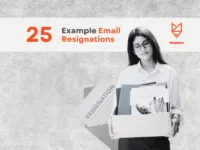Crafting the right email subject line can make a big difference in your sales results. A strong subject line grabs attention and encourages the recipient to open your email, which is the first step in closing a sale. By focusing on clarity and relevance, you can set your messages apart from countless others in crowded inboxes.
Think about what makes you click on an email. It often comes down to curiosity or a promise of value. Using action-oriented words and clear benefits in your subject lines can motivate your audience to engage. Keep it concise and intriguing to spark interest while highlighting what’s in it for them.
In this blog post, you’ll learn effective strategies for writing compelling subject lines that lead to higher open rates and better sales outcomes. Discover tips and examples that will help you connect with your audience and increase your chances of conversion.
Effective Email Subject Lines For Sales
Email subject lines are your first chance to grab attention. A well-written subject line can make the difference between your email being opened or ignored.
Consider these points:
- First Impressions Matter: Your subject line is what recipients see first. It sets the tone and expectation for your message.
- Grab Attention Quickly: Use clear and direct language. Aim for something catchy yet relevant.
- Improve Open Rates: Studies show that personalized and concise subject lines tend to perform better.
Best Practices:
- Keep it Short: Aim for 6-10 words. Long subject lines may get cut off.
- Use Action Words: Start with action verbs to inspire engagement. Words like “discover,” “join,” or “save” encourage action.
- Create Urgency: Phrases like “limited time offer” can motivate readers to open the email quickly.
- Add Personal Touch: Including the recipient’s name can increase open rates. Tailor your subject lines to match their interests.
Incorporating these techniques will help you create effective subject lines. You’ll increase the likelihood of your emails getting opened and read. Remember, your subject line is a key part of your sales strategy.
Understanding Your Sales Audience
Knowing your sales audience is crucial. This helps you create email subject lines that catch their attention.
Start by identifying who your audience is. Consider factors like:
- Age
- Location
- Industry
- Job Title
- Interests
These details shape what your audience cares about. Tailor your message to fit their needs.
Next, think about their pain points. What problems do they face? If you address these issues, they are more likely to engage with your emails.
Use language that resonates with them. For example, if you’re targeting young professionals, keep the tone light and modern. For corporate executives, use a more formal approach.
Consider their buying behaviors too. Understand where they are in the buying process:
- Awareness Stage: They may not know your product yet.
- Consideration Stage: They are evaluating options.
- Decision Stage: They are ready to buy.
Craft your subject lines to reflect this stage. For instance, use questions for the awareness stage and special offers for the decision stage.
Finally, test different subject lines to see what works best. Open rates can tell you a lot about your audience’s preferences. Adjust your strategy based on this feedback to improve your results.
Key Principles for Engaging Email Subject Lines for Sales
Creating effective subject lines can significantly impact your email open rates. Here are some key principles to keep in mind:
- Be Clear and Concise: Aim for 6-10 words. If your subject line is too long, recipients might not see it all.
- Use Action Words: Start with strong verbs. This encourages readers to take action. For example, “Discover How to Save” grabs attention.
- Create Urgency: Phrases like “Limited Time Offer” prompt readers to act quickly. Use deadlines or scarcity to enhance urgency.
- Personalize When Possible: Including the recipient’s name or specific details makes the email feel more relevant. For example, “John, Your Special Discount Awaits” is more engaging.
- Ask a Question: Questions can spark curiosity. For instance, “Ready to Boost Your Sales?” encourages recipients to find out more.
- Use Numbers and Lists: Subject lines with numbers can be eye-catching. For example, “5 Tips to Increase Sales” suggests value and clarity.
- Test and Analyze: Experiment with different subject lines to see what works best. Track open rates to understand what resonates with your audience.
By following these principles, you can craft engaging subject lines that draw readers in and encourage them to open your emails.
Personalization Techniques in Subject Lines
Personalization can make your email subject lines more engaging. You can connect better with your recipients by using their names, targeting specific groups, and reacting to their behavior.
Using Recipient Names
Including a recipient’s name in the subject line can increase open rates. This small adjustment makes the email feel more personal and relevant. For example, instead of “Big Sale This Week,” use “Sarah, Don’t Miss Our Big Sale!”
When you use names, it shows you value the individual. Keep it natural and avoid overusing names in different emails. Using names effectively reveals a connection and grabs attention.
Segmentation Strategies
Segmentation means dividing your audience into smaller groups based on shared traits. You can categorize by location, interests, or past purchases. This way, your subject lines can be tailored to fit each group.
For example, if you sell sports equipment, send one email to your running enthusiasts and another to your cycling fans. Each subject line can reflect the specific interests of these groups.
This strategy makes your emails more relevant, which can lead to higher open rates and better response. Consider creating segments based on customer behavior for the best results.
Behavior-Triggered Email Topics
Behavior-triggered emails respond to specific actions taken by the recipient. For instance, if someone abandons their shopping cart, an email like “John, Complete Your Purchase Today!” can prompt them to return.
You might also send follow-up emails after a purchase. Use subject lines that reference the bought item’s benefits, like “Michael, Enjoy Your New Headphones!” These techniques create urgency and motivate responses.
By focusing on actions, you can make your subject lines timely and relevant, increasing the chances that your emails will be opened.
Power Words and Phrases to Increase Open Rates
Using power words and phrases in your email subject lines can boost your open rates. These words grab attention and create curiosity.
Here are some effective power words you can include:
You can also use phrases that imply urgency or appeal to emotions. Check out these examples:
- “Act Now”
- “Don’t Miss Out”
- “Join Us Today”
These phrases encourage readers to open your email right away. Avoid generic phrases like “Update” or “Newsletter.” They may not stand out in a crowded inbox.
Remember, keeping it short and clear is key. Aim for around 6-10 words in your subject line. This makes it easier for readers to see the main idea quickly.
Mix and match these words and phrases to find what resonates best with your audience. Test different subject lines to see which ones lead to higher open rates.
Email Subject Lines For Sales
Creating a Sense of Urgency
Creating urgency in your email subject lines can boost your sales. People respond well when they feel they need to act quickly. Here are some effective strategies:
- Use Time Limits: Phrases like “24-Hour Flash Sale” or “Only 3 Days Left” encourage quick action.
- Highlight Scarcity: Words such as “Limited Stock” or “Only a Few Left” make your offer seem rare.
- Include Action Words: Start with strong verbs like “Grab,” “Don’t Miss,” or “Act Now” to prompt immediate responses.
Here are some examples of urgent subject lines:
You can also create urgency by addressing customer needs. For example, if your product solves a problem, mention the benefit directly.
A clear subject line that communicates urgency can increase open rates and drive sales. Your goal is to make customers feel they might miss out if they don’t act now.
Clarity and Brevity in Subject Lines
Clear and brief subject lines make your emails more effective. Readers often scan their inbox quickly. If your subject line is too long or confusing, they might not open your email.
Aim for 5-7 words. This length is enough to give a clear idea of your message.
Tips for Clarity and Brevity:
- Be Direct: Use straightforward language. Avoid complicated words.
- Use Action Words: Start with verbs like “Get,” “Join,” or “Discover.” These prompt action.
- Numbers Work: Lists or offers catch attention. For example, “5 Tips for Boosting Sales” is clear and specific.
Examples:
Avoid using vague phrases like “Check this out.” It doesn’t tell the reader what to expect.
Remember, your goal is to grab attention. Keep it clear, concise, and relevant to what you are offering.
50 Example Email Subject Lines for Sales
50 Example Email Subject Lines for Sales
- Get 20% Off Your Next Purchase!
- Don’t Miss Out on This Special Offer!
- Unlock Your Exclusive Discount Today!
- Last Chance to Save Big!
- Your Free Gift Awaits!
- Limited Time: Buy One, Get One Free!
- Discover What Everyone’s Talking About!
- Special Deal Just for You!
- How to Boost Your Savings Today!
- You’re Invited to an Exclusive Event!
- Ready to Transform Your Experience?
- Your Opinion Matters: Share & Save!
- The Secret to Effortless Shopping!
- Take a Sneak Peek at Our Newest Product!
- Join Our VIP List for Special Offers!
- Act Fast: Supplies are Limited!
- See What’s New This Month!
- You Deserve This Exclusive Deal!
- Unlock Hidden Savings Now!
- Your Next Adventure Starts Here!
- Have You Checked Out Our Latest Collection?
- Get Ready for a Major Upgrade!
- Don’t Wait—Claim Your Discount!
- You’re Just One Click Away from Savings!
- Time to Treat Yourself—Here’s How!
- Why Wait? Shop Now for the Best Deals!
- Your Feedback Could Save You Money!
- A Surprise Gift Just for You!
- The Best Deals Are Here—Don’t Miss Out!
- Meet Your New Favorite Product!
- We’ve Got Something Special Just for You!
- Let’s Make Your Day Brighter with This Deal!
- Your Perfect Match is Waiting!
- You’re Selected for Our Exclusive Offers!
- Ready to Experience Something New?
- Save More When You Shop with Us!
- Enjoy the Benefits of Being a Member!
- Join the Thousands Who Love This!
- Here’s a Deal You Can’t Refuse!
- Get More for Less Today!
- Uncover Your Next Great Purchase!
- Your Path to Savings Starts Here!
- This Week Only: Hot Sales Just for You!
- Be the First to Know About New Arrivals!
- Special Offer Inside—Open to Unlock!
- Take These Tips to Save Big!
- Here’s What You’ve Been Waiting For!
- Sometimes, You Just Need a Great Deal!
- Your Perfect Deal is a Click Away!
- Don’t Let This Offer Slip Away!
These subject lines can help create interest and drive sales effectively.
Testing and Optimizing Email Subject Lines
Testing and optimizing subject lines is key to increasing email open rates. You can use various methods to find out what works best for your audience. Focus on experimenting, analyzing data, and responding to feedback.
A/B Testing Methods for Email Subject Lines for Sales
A/B testing lets you compare two versions of a subject line. You create two emails with different subject lines and send them to a small audience first.
After a short time, you measure which subject line had a higher open rate. Choose a clear variable to test, like the wording or length.
Once you identify the winning subject line, send it to the rest of your list. Repeat this process regularly to continuously improve your subject line performance.
Analyzing Open Rate Metrics
Measuring open rates provides important insights. Open rate is calculated as the number of emails opened divided by the number of emails sent.
Here are some key metrics to track:
- Open Rate: Shows the percentage of recipients who opened your email.
- Click-Through Rate: Indicates how many people clicked on links within your email.
- Bounce Rate: Reflects the percentage of emails that could not be delivered.
By analyzing these metrics, you can identify what works. Look for patterns to find what types of subject lines grab your audience’s attention.
Adapting to Audience Feedback
Audience feedback is crucial for fine-tuning your subject lines. Pay attention to responses and engagement levels.
Ask your subscribers for opinions through surveys or feedback forms. Use their insights to shape your content and approach.
Monitor social media and email replies for trends too. Adapt your subject lines based on what resonates with your audience. This helps ensure your emails stay relevant and effective.
Email Subject Lines and Mobile Optimization
More than half of emails are opened on mobile devices. Optimizing your email subject lines for mobile is essential.
Keep it Short
Aim for 30-40 characters. Longer subject lines may get cut off on small screens.
Focus on Key Information
Put the most important words first. This ensures they are visible even if the subject line is truncated.
Use Actionable Language
Words like “Get,” “Join,” or “Discover” encourage quick action. They create a sense of urgency that appeals to mobile users.
Emojis Can Help
Adding emojis can catch attention quickly. Use them sparingly and ensure they match your brand tone.
Test Different Variations
A/B testing helps you see what works best. Experiment with wording, length, and emoji usage to learn what your audience prefers.
Mobile-Friendly Formatting
Ensure that links and calls to action in your emails are easy to click on mobile devices. This keeps readers engaged.
Utilizing these strategies will improve your email open rates. Make sure your subject lines stand out in crowded inboxes.
Compliance and Best Practices
When crafting email subject lines, it’s essential to follow best practices that ensure compliance with laws and improve engagement. Focusing on avoiding spam triggers and adhering to email marketing regulations can enhance your email campaigns.
Avoiding Spam Triggers
To keep your emails from landing in the spam folder, be mindful of your word choices. Avoid excessive use of all caps and exclamation marks. These often raise red flags.
Here are some key points to consider:
- Use clear language: Avoid jargon or overly promotional words like “free” or “winner.”
- Be concise: Keep subject lines to about 6-10 words.
- Personalize: Include the recipient’s name for a personal touch.
Testing your subject lines can also help. Use A/B testing to see what works best and adjust your strategies accordingly.
Following Email Marketing Regulations
Understanding and following email marketing regulations is crucial. This includes laws like the CAN-SPAM Act (for the U.S.) and GDPR (for Europe).
Key regulations to follow include:
- Consent: Always obtain permission before sending marketing emails.
- Easy opt-out: Include a visible and straightforward way for recipients to unsubscribe.
- Accurate information: Provide a valid physical address and clear identification of your business.
By respecting these guidelines, you improve your reputation and maintain the trust of your audience.
Leveraging Seasonality and Events
Using seasonality and events can boost your email subject lines. People respond well to timely messages. Keep your audience engaged by connecting your product or service to what’s happening right now.
Key Seasons to Consider:
- Holidays: Christmas, Halloween, Valentine’s Day
- Seasonal Changes: Spring sales, summer vacations
- Cultural Events: Sports tournaments, local festivals
Incorporating these themes into your subject lines makes them more relevant. For example, use phrases like “Spooky Savings for Halloween” or “Spring Into Our New Collection.”
Tips for Effective Subject Lines:
- Be Specific: Mention the event.
- Create Urgency: Use words like “Limited Time” or “Now.”
- Personalize: Use recipient names when possible.
Example Subject Lines:
- “Get Ready for Black Friday Deals!”
- “Celebrate Summer with 20% Off!”
By tailoring your messages to align with current events, you can capture attention and drive opens. Track which seasonal campaigns perform best for future reference.
The Role of Visual Elements in Subject Lines
Visual elements can make your email subject lines stand out. Simple changes can attract more attention from your audience.
Examples of Visual Elements:
- Emojis: These can add color and personality. For example, a 📈 can signal growth or success.
- Symbols: Using symbols like * or # can draw the eye. They can make your subject line unique.
- Capitalization: Capitalizing important words can emphasize your main point. This helps it pop out.
Benefits:
- Increased Open Rates: Eye-catching elements can make people more likely to open your email.
- Brand Recognition: Consistent use of certain visuals can make your brand recognizable.
- Emotional Connection: Visuals, like emojis, can create a friendly tone and connect with your audience.
Make sure the visuals you choose are relevant to your message. Misleading elements can confuse readers.
A good balance of text and visuals can enhance clarity. Keep your subject lines focused and direct. Always consider your audience and what visuals will resonate with them.
Crafting Retargeting Email Subject Lines
Retargeting emails are a great way to reach customers who showed interest but didn’t convert. The subject line is crucial for grabbing their attention. Here are some tips to help you create effective retargeting email subject lines.
- Be Direct: Use clear language that speaks to what the customer did. For example, “You Left Something in Your Cart!”
- Create Urgency: Encourage action by highlighting a time limit. Try phrases like, “Only 24 Hours Left to Complete Your Purchase!”
- Personalize: Use the customer’s name or mention previous interactions. A subject line like, “Hi [Name], Here’s what you missed!” works well.
- Incorporate Discounts: If applicable, mention a discount to entice them. “Get 20% Off Your Fave Item!” stands out.
- Ask a Question: Engaging questions can spark curiosity. For instance, “Still Interested in [Product Name]?” invites a response.
Examples of Effective Subject Lines
Using these strategies can improve your chances of re-engaging customers. Test different approaches to see what works best for your audience.




